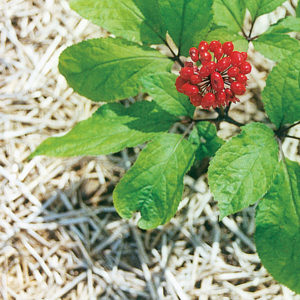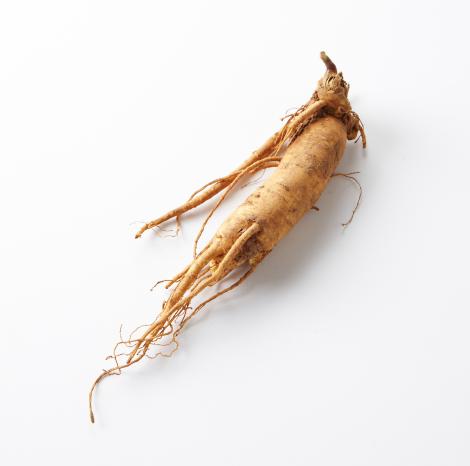
Mature ginseng with berries
Ginseng (Panax spp.) has a long history of medicinal use in Asia. Although in the past it has been used as an aphrodisiac, a muscle relaxant and to treat diabetes, its most popular use has been as a tonic to promote good health. Modern scientific studies have not been able to confirm the medicinal qualities claimed for it, but it is still hugely popular. It is the root that is used despite the fact that the ginsenosides that are the active ingredient are more prevalent in the stems and leaves.
There are four types of ginseng. The most popular is the South China ginseng (P. notoginseng) which is native to Southwest China and Viet Nam. It is considered the most potent. There is also the Korean ginseng (P. ginseng) which is found on the Korean peninsula, northeastern China and Far East Russia. American ginseng (P. quinquefolius) is native to Northeastern US and Canada. Vietnamese ginseng (P. vietnamensis) is found only in Viet Nam.
The roots of all four types of plants are used to produce the green, white or red ginseng that is sold. Green, or fresh, ginseng is just that. The roots are raw and unprocessed. White ginseng are roots that have been air dried in the sun. These roots are less potent because sunlight breaks down the ginsenosides. It is called “white” because the sun bleaches the roots to a yellowish-white color. Red ginseng are roots that have been peeled, steamed and then dried. Steaming the roots gives them a reddish color.
Wild ginseng was over-harvested in the US and now only grows in a few areas. Harvesting of the wild plants is illegal in most areas so farmers have turned to growing it. Growing ginseng is a lucrative cash crop. Prices of $500 per pound of the roots are not unheard of. However, it requires the right growing conditions and a lot of patience. It can take 5 to 10 years before the plants are mature enough to harvest.
How to Grow Ginseng
Ginseng has very specific needs. It’s a woodland plant requiring 70% to 80% shade. It grows best in hardwood forests where the canopy is dense enough to discourage the growth of most other plants. Pine forests are too acidic. Ginseng does not compete well with grasses and other weeds. It also requires the good drainage found on slopes. Northern and eastern facing slopes are best because they are cooler than slopes that face south or west. Ginseng is a cool weather plant. It does not grow in the southeastern parts of the US except in the Appalachian Mountains where it is cooler.
Most growers choose to purchase roots to start in their woodland plots on their farms. Ginseng seeds take two years to germinate. If you want to start from seed, which is cheaper than roots, be sure to purchase cold stratified seeds. These seeds will germinate the spring after they are planted. Fresh seed is cheaper than cold stratified seed, but it will take two years to germinate. In the wild, the long germination period is due to the length of time needed for the thick berries to decay and expose the seeds. Then the seeds need to experience the cold of winter.
You can cold stratify your seeds yourself by either planting the seeds immediately after the berries decay or by sowing them in a container which is then buried in your garden for the winter. Plant those seeds in the fall. Seeds should be planted ¼ inch deep and 6 inches apart in rows that are 9 inches apart. Cover them with a 2 inch layer of organic mulch such as shredded leaves, sawdust or shredded bark. This will protect the seeds from extreme cold and help the soil retain moisture over the winter.
If you are growing from roots, they should be planted in holes at a 45⁰ angle to ensure good drainage in the fall with the bud resting 1 inch below the soil. Plan on a spacing of 6 to 12 inches apart in rows 6 to 12 inches apart. If your roots arrive and your woodland garden is not yet ready for them, they can be stored in your refrigerator over the winter and planted in the spring as soon as the soil can be worked.
Once your seeds or roots are planted, the garden needs no further care from you. You don’t need to water it or weed it. Be prepared for wild animals to browse the plants. Keep an eye on the plants for any signs of disease and remove any diseased plants.
How to Harvest Ginseng
Ginseng is ideally harvested when it is between 8 and 10 years old. The first year of growth, the plants will push up a single stem with three leaves on it. This is known as a prong. The second year, the prong will have five leaves on it. Each subsequent year, the plants will add prongs or leaves. A mature plant that is ready for harvest has four prongs with a total of 20 leaves.
Harvest the roots in the fall when the tops have begun to die, Gently slide the times of a garden fork into the ground 6 inches from the plant and gently lift the soil with the root in it. Soak the roots in water to loosen the soil, then wash it off with a hose. Try not to break the rootlets or hairs. It is thought that the medicinal ingredients are concentrated in the roots and hairs. Dry the roots on a wooden rack. Do not use a screen or any other metal. Dry the roots away from sunlight. They will be light brown in appearance when dried. Roots with the hairs and rootlets intact or that look like humans command higher prices.

